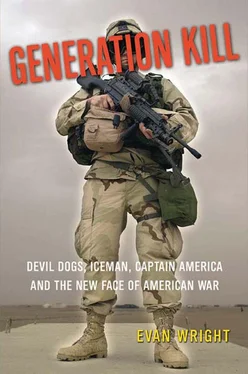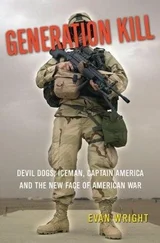Now leading his team—“a ragtag mishmash of men,” as he calls them in his diary—on their first combat mission is a chance to fulfill all his dreams. They follow the berm of a small canal, running north-south. Their objective is a hut about 150 meters away. As they bound toward it, an Iraqi man pops out of the field in front of them. Scott and his men raise their weapons to shoot him, but the Iraqi is unarmed. He gestures to them, speaking in Arabic. Scott fears it’s a trap. Maybe he’s there to lead them into an ambush.
But before he can take any action, three mortars explode nearby on the western side of the structure. The Iraqi disappears as Scott and his men take cover. Then rounds slam into the ground all around them. Scott’s men try shooting. His M-4 jams on a double feed—two rounds stuck in the chamber—and a SAW gunner’s weapon also malfunctions, popping off just one round at a time. Another gunner on his team succeeds in laying down a steady bead of fire.
About this time they notice that all the red tracers streaming in at them are coming from the west, where Marines from Task Force Tarawa are hunkered down. The mini-firefight is Marines shooting at Marines.
Scott’s men stop shooting, as do the Marines firing at them in the distance. In his diary that night, Scott writes a considerably more concise and less florid entry than his previous ones: “Combat was not what I expected. How we all made it out without a scratch is beyond me.”
IN ADDITION TO THE PROBLEM of friendly fire, Patterson’s Alpha Company snipers on the riverfront are dealing with the ambiguities of guerrilla war, not covered in the Marine Rules of Engagement. The ROE under which the Marines operate are quite naturally based on the assumption that legitimate targets are people armed with weapons. The problem is Iraqis dressed in civilian clothes who are armed not with guns but with cell phones, walkie-talkies and binoculars. These men, it is believed by the Marines, are serving as forward observers for the mortars being dropped into their positions.
Mortars are a weapon of choice for the Iraqis. A mortar is a rocket-propelled bomb that is launched from a tube that’s about a meter long. The mortar rocket itself is about the size and shape of a bowling pin. It fires out of the tube almost straight up, then arcs down and explodes—anywhere from one to six kilometers away. Even the smaller mortars used by the Iraqis will, when they hit, scoop out about a meter-wide hole in the ground and spray shrapnel for twenty-five meters in all directions. A direct hit from a mortar can disable the biggest American tank, or blow the fuck out of a Humvee.
Since mortars are small and light, they can be moved around easily and fired from rooftops, trenches, alleys, even from the backs of pickup trucks. Even better from the enemy’s standpoint, you can’t tell which direction they’re being fired from. They might be five kilometers away in a trench behind a house or an apartment block.
But since mortar crews are so far away and usually out of sight, they rely on forward observers. These characters tend to hang out near Marine positions with binoculars, cell phones or radios. They watch where the mortars are landing and call back to the guys shooting them to tell them how to adjust their fire. Those who appear to be observers in Nasiriyah are unarmed, dressed in civilian clothes and blend in with the population.
During the first hour by the river, Marine snipers had to request permission up the chain of command to get “cleared hot” to shoot suspected forward observers. Killing unarmed civilians is a dicey issue, but eventually the Marine snipers are given permission to take out Iraqis with binoculars or cell phones on the other side of the river.
Marine snipers work in two-man teams, a shooter and a spotter. One of the best teams in Alpha Company is led by thirty-nine-year-old Sergeant Ken Sutherby, originally from Michigan. Sutherby looks and talks exactly the way you’d expect a Marine sniper to. He is tall and gaunt, with unblinking, pale-blue eyes, and speaks in a dry, almost airless voice. His laconic mannerisms are no doubt reinforced by the fact that Sutherby is slightly hearing impaired. He carefully scrutinizes anyone speaking to him in case he misses a word. When you get to know him, he emerges as something of a character, like a vaguely improbable figure in an Elmore Leonard crime novel.
Sutherby has been in and out of the Marine Corps since the age of nineteen. Between his years as a rifleman and sniper, he’s worked as a car repo man in his hometown of Detroit, as a bodyguard for members of the Saudi royal family in Beverly Hills, and most recently, again as a bodyguard, this time for Suge Knight, the hip-hop mogul and convicted felon behind Death Row Records. Sutherby rejoined the Marines this last time because “it’s more stable than working in the civilian world.”
Beneath it all, Sutherby is basically a family man. He and his wife have four kids of their own and provide foster care to as many abused and neglected children. “I enjoy my family,” he says. In fact, he calls his M-40 sniper rifle “Lila,” which stands for “Little Angel,” his nickname for his youngest daughter.
Sutherby and Lila get their first kill at about three o’clock in the afternoon. While nearby Marines in Alpha pour fire into buildings and windows across the river, where they think there are enemy gunmen, Sutherby and his spotter observe an Iraqi man in what they describe as “black pajamas,” behaving suspiciously in an alley. He’s about 400 yards distant (for some reason, while the rest of the Corps is metric, snipers still do everything in yards), and he seems to be watching the Marines through a pair of binoculars.
Sutherby and his spotter crouch behind a low brick wall. He props Lila on a sandbag for stabilization and watches the Iraqi in black pajamas for a good ten minutes. Every time mortars boom on the Marines’ side of the river, the Iraqi steps out in the alley. On his last trip out, Sutherby takes a chest shot.
Sutherby seldom gets to see the results of his work. As soon as he takes the shot, the recoil jiggles his scope, blurring his vision. But his spotter, a twenty-two-year-old, Corporal David Raby from Nashville, Tennessee, sees the man go down. A minute later another Iraqi steps into the same alley with a pair of binoculars, perhaps even those from the man Sutherby just shot. He takes out the second guy with another chest shot.
After another hour, Sutherby and Raby see a man in an alley who has binoculars and a cell phone or radio. He is 500 yards away, and more careful than the first two. He appears every fifteen minutes or so, popping his head out from around a corner. Sutherby and Raby are forced to wait half an hour until the guy lingers long enough to get a clean shot. By this time, Sutherby’s eyes are fatigued. He rests on Lila’s stock, with his eyelids closed, until Raby says, “Sutherby! You see him?”
Sutherby opens his eyes and kills the man. It’s a perfect head shot. In fact, Sutherby has the rare satisfaction of seeing the kill. The man’s hands jerk up to his face while he tumbles forward.
Sutherby doesn’t think about much in the way of philosophical or spiritual matters when he’s killing people. The only things going through his mind are “shot geometry, yardage, wind.” After his third kill, however, he does take pleasure in noting a marked decline in enemy mortar fire.
BY FOUR IN THE AFTERNOON, the smoke and dust are so thick, our position by the bridge at Nasiriyah is engulfed in a sort of permanent twilight. Finally, after being absent for the past two hours, helicopter gunships—both Cobras and Hueys—show up. They nose down over a palm grove across the road, taking passes with rockets and machine guns, spitting out white smoke trails and red tracer streaks. Fireballs bloom from the trees below. The 20mm machine guns fired by the Cobras are beyond loud—you can feel the buzzing sound they make deep in your chest. The Hueys, which are shaped like tadpoles, fire lighter machine guns operated by door gunners. You’ve seen Hueys in just about every Vietnam War movie ever made, as they were a staple of the U.S. military in that conflict. Seeing them now, flying over the flaming palm grove, it suddenly feels like we’ve stumbled onto the set of Apocalypse Now.
Читать дальше












